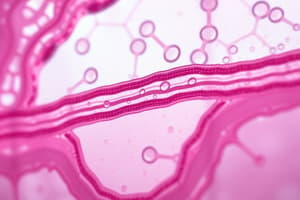Podcast
Questions and Answers
What is the main function of tight junctions in epithelial cells?
What is the main function of tight junctions in epithelial cells?
- To restrict the movement of substances through the intercellular space (correct)
- To facilitate the exchange of ions between cells
- To provide structural support to the epithelial cells
- To allow for the free movement of molecules between cells
What is the term for the space between epithelial cells?
What is the term for the space between epithelial cells?
- Intercellular cavity
- Basolateral space
- Lateral intercellular space (correct)
- Apical space
What is the function of the apical membrane of epithelial cells?
What is the function of the apical membrane of epithelial cells?
- Faces the basement membrane
- Faces the blood
- Faces the lumen of the organ or body cavity (correct)
- Faces the lateral intercellular space
What is the term for the process by which epithelial cells can absorb or secrete substances?
What is the term for the process by which epithelial cells can absorb or secrete substances?
What is the term for the disorder characterized by the inability to absorb glucose and galactose?
What is the term for the disorder characterized by the inability to absorb glucose and galactose?
What is the term for the passage of glucose into the urine?
What is the term for the passage of glucose into the urine?
What is the function of the fence-like structure formed by tight junctions?
What is the function of the fence-like structure formed by tight junctions?
What is the main function of the basolateral membrane of epithelial cells?
What is the main function of the basolateral membrane of epithelial cells?
What is the primary mechanism of transcellular transport?
What is the primary mechanism of transcellular transport?
Which of the following is an example of transcellular transport?
Which of the following is an example of transcellular transport?
What is the function of tight junctions in paracellular transport?
What is the function of tight junctions in paracellular transport?
What is the main difference between transcellular and paracellular transport?
What is the main difference between transcellular and paracellular transport?
What is the role of GLUT proteins in transcellular transport?
What is the role of GLUT proteins in transcellular transport?
Which pathway is involved in the transport of water and ions in the kidney?
Which pathway is involved in the transport of water and ions in the kidney?
What is the significance of different domains in epithelial transport?
What is the significance of different domains in epithelial transport?
What is the primary function of the epithelial barrier?
What is the primary function of the epithelial barrier?
Flashcards are hidden until you start studying
Study Notes
Epithelial Structure and Function
- Epithelial cells are arranged in continuous sheets in single or multiple layers, sitting on a basement membrane.
- They form the boundary between the body's organs or between the body and external environment.
- Epithelial cells are subject to physical breakdown and injury, undergoing constant and rapid renewal process.
Epithelial Cells and Tight Junctions
- Epithelial cells are separated from their neighbours by the lateral intercellular space.
- Tight junctions hold epithelial cells together at their luminal edges, forming a barrier.
Tight Junctions
- Tight junctions are composed of thin bands that encircle the cell and make contact with thin bands from adjacent cells.
- In electron microscopy, tight junctions appear as fused membranes.
- In freeze fracture, tight junctions appear as an interlocking network of ridges in the plasma membrane.
- Tight junctions restrict the movement of substances through the intercellular space between cells.
- They prevent membrane proteins from diffusing in the plane of the lipid bilayer.
- Tight junctions separate the epithelial cells into two distinct membrane domains: apical (or luminal or mucosal) membrane and basolateral membrane.
Epithelial Transport Properties
- The barrier function of tight junctions means that certain molecules can enter or leave the intercellular space.
- Different domains use different transporters to move substances into or out of the cell.
- Transport can occur via the paracellular or transcellular pathway or both.
Transcellular Transport
- Definition: Transcellular transport refers to the movement of substances through the interior of epithelial cells, crossing both the apical and basolateral membranes.
- Mechanism: Substances can cross the cell membrane via passive diffusion, facilitated diffusion, or active transport processes.
- Examples: Nutrient absorption in the intestine often involves transcellular transport, such as glucose absorption through facilitated diffusion.
Paracellular Transport
- Definition: Paracellular transport refers to the movement of substances through the space between adjacent epithelial cells, crossing the epithelial barrier without passing through the cytoplasm of the cells.
- Mechanism: Paracellular transport relies on tight junctions, allowing small molecules, ions, and water to pass through via diffusion or solvent drag.
- Examples: In the kidney, paracellular transport plays a role in the reabsorption of water and ions, such as in the proximal tubule.
Glucose Absorption
- Glucose absorption in the intestine and kidney occurs through transcellular transport.
- Glucose/galactose malabsorption syndrome occurs when there is a defect in glucose absorption.
- Glucosuria in the kidney occurs when there is excess glucose in the urine.
Studying That Suits You
Use AI to generate personalized quizzes and flashcards to suit your learning preferences.




